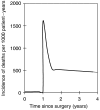Reducing uncertainty in health-care resource allocation
- PMID: 17519908
- PMCID: PMC2359979
- DOI: 10.1038/sj.bjc.6603795
Reducing uncertainty in health-care resource allocation
Abstract
A key task for health policymakers is to optimise the outcome of health care interventions. The pricing of a new generation of cancer drugs, in combination with limited health care resources, has highlighted the need for improved methodology to estimate outcomes of different treatment options. Here we introduce new general methodology, which for the first time employs continuous hazard functions for analysis of survival data. Access to continuous hazard functions allows more precise estimations of survival outcomes for different treatment options. We illustrate the methodology by calculating outcomes for adjuvant treatment of gastrointestinal stromal tumours with imatinib mesylate, which selectively inhibits the activity of a cancer-causing enzyme and is a hallmark representative for the new generation of cancer drugs. The calculations reveal that optimal drug pricing can generate all win situations that improve drug availability to patients, make the most of public expenditure on drugs and increase pharmaceutical company gross profits. The use of continuous hazard functions for analysis of survival data may reduce uncertainty in health care resource allocation, and the methodology can be used for drug price negotiations and to investigate health care intervention thresholds. Health policy makers, pharmaceutical industry, reimbursement authorities and insurance companies, as well as clinicians and patient organisations, should find the methodology useful.
Figures

References
-
- Berenson A (2005) Cancer drugs offer hope, but at huge expense. NY Times (Print), A1, C3 - PubMed
-
- Boyle P, Ferlay J (2005) Cancer incidence and mortality in Europe, 2004. Ann Oncol 16: 481–488 - PubMed
-
- Breslow NE, Day NE (1987) Statistical Methods in Cancer Research. Volume II–The Design and Analysis of Cohort Studies. IARC Scientific Publication No. 82. Lyon: International Agency for Research on Cancer, pp 131–135 - PubMed
-
- Buchdunger E, Zimmermann J, Mett H, Meyer T, Muller M, Druker BJ, Lydon NB (1996) Inhibition of the Abl protein-tyrosine kinase in vitro and in vivo by a 2-phenylaminopyrimidine derivative. Cancer Res 56: 100–104 - PubMed
-
- Danaei G, Vander Hoorn S, Lopez AD, Murray CJ, Ezzati M (2005) Causes of cancer in the world: comparative risk assessment of nine behavioural and environmental risk factors. Lancet 366: 1784–1793 - PubMed
MeSH terms
LinkOut - more resources
Full Text Sources
Medical
Miscellaneous

